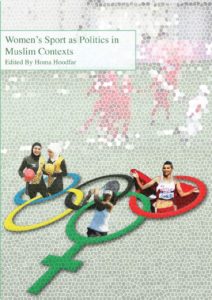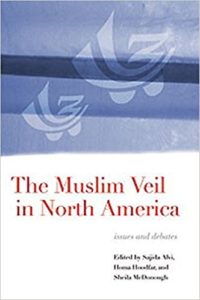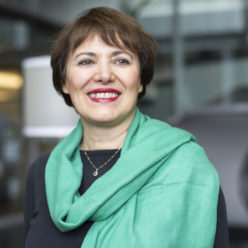Women’s Sport as Politics in Muslim Contexts

London: Women Living Under Muslim Laws (2015)
ISBN/ISSN: 978-1-907024-20-7
Download volume here. 3.87 MB.
This book provides an urgently needed analysis of the bravery and creativity exhibited by women in the realm of sports, which has emerged as a major realm of contestation between proponents of women’s rights and political Islamist forces in Muslim contexts. Through focused case studies, this volume tracks the many sophisticated, context-specific, and constantly evolving strategies of women’s resistance to their exclusion in sport. Integral in their struggles for full inclusion in competitive sports, as both players and spectators, is women’s claim to their full and equal citizenship. The edited volume divulges the various ways women negotiate political and ideological boundaries, as they politicize and subvert spaces normally considered outside the realm of state politics in order to bring about gender equitable opportunities while at the same time redefining women’s roles in society.
Hoodfar and other contributors have provided a ground-breaking analysis of the landscape of gender and sports in diverse Muslim contexts, covering Iran, Saudi Arabia, Turkey, Bangladesh, Europe, North America, and Senegal. This book offers a glimpse of the variety of ways that women debunk exclusionary masculinist logics in sports that are justified by nationalism, religion, and modernism. In the process they also expose, unpack, and critique, the policies and tactics imposed by both international mega-sport organizations and Islamist regimes that objectify and sexualize women’s bodies in their opposing perspectives.
The various chapters of the book document women’s insistence in participating in and politicising sports, which challenges and redefines gender norms that prevail in their specific context. This fascinating case studies that documents the variety of ways that women in Muslim contexts have initiated strategies to contest their exclusion from the public sphere, is part of the WLUML’s research and publication series on Dress Codes and Modes: Politics of Women’s Clothing in Muslim Contexts.The book is written in an accessible manner and is a timely resource for proponents of sports for women. It also serves teachers and scholars interested in women’s sports and resistance, as well as cultural and post-colonial studies. This book is an important and inspiring resource for feminists, activists, and scholars who are committed to ending the exclusion of women from sports, which is an important aspect of the public sphere.
Sexuality in Muslim Contexts: Restrictions and Resistance

Edited by Anissa Helie and Homa Hoodfar
London: Zed Books (2012)
This ground breaking book explores resistance against the harsh policing of sexuality in some Muslim societies. Many Muslim majority countries still use religious discourse to enforce stigmatization and repression of those, especially women, who do not conform to sexual norms promoted either by the state or by non-state actors. In this context, Islam is often stigmatized in Western discourse for being intrinsically restrictive with respect to women’s rights and sexuality. The authors show that conservative Muslim discourse does not necessarily match practices of believers or of citizens and that women’s empowerment is facilitated where indigenous and culturally appropriate strategies are developed. Using case studies from Pakistan, Iran, Indonesia, China, Bangladesh, Israel and India, they argue persuasively that Muslim religious traditions do not necessarily lead to conservative agendas but can promote emancipatory standpoints. An intervention to the construction of ‘Muslim women’ as uniformly subordinate, this collection spearheads an unprecedented wake of organizing around sexualities in Muslim communities.
Electoral Politics: Making Quotas Work for Women

By Homa Hoodfar and Mona Tajali
London: WLUML (2011)
Download book here.
Despite much research and advocacy goal of reducing gender inequalities in political representation has been elusive in many different kinds of political systems, even though women have made substantial progress in other areas, such as education, employment and healthcare. In this context and in the march towards inclusive democracy and addressing women’s historical exclusion from electoral processes, gender quotas have emerged across the North and the South as a major tool for redress the issue of underrepresentation of women in electoral and party politics. This accessibly written book lays out the history of this approach across the globe along with analysis of eight case studies to show case the varieties of structural and strategical reasons behind quotas differential rate of success.
The book argues that gender quotas, though can be an effective strategy, in and of themselves, are not an ‘easy fix’ for elimination gender discrimination. The book’s comparative approach untangles the various factors which need to be considered in designing, lobbying for, and implementing gender quotas so that they can be effective. This volume is tremendously useful and informative for advocates, policy makers, and scholars interested in gender equality in representative politics across the globe and does a masterful job explaining divergent outcomes both within regions and across them. While teasing out some shared experiences, it encourages coalitions of advocates to develop context-appropriate strategies to craft effective campaigns to end women’s exclusion from political decision-making. The authors argue that although increasing countries are successfully and creatively using gender quotas, lack of attention to the political structure and culture of party politics, some of the wealthiest long-standing democracies still continue to experience greater legislative gender inequalities.
The Muslim Veil in North America: Issues and Debates

Edited by Sajida Alvi, Sheila McDonough, and Homa Hoodfar
Toronto: Canadian Scholars’ Press (2003).
The issue of the hijab (veil) has been divisive for the Muslim community in North America. Muslims themselves see different meanings in covering their heads. The wider North American society also reacts in diverse ways to the Muslim veil; some read into the practice elements of oppression of women and extreme patriarchal attitudes. Others see it as a harmless mode of self-expression. Beginning in 1996, the Canadian Council of Muslim Women invited scholars from various fields to carry out a systematic study of issues surrounding different practices relating to the hijab among Muslims. This provocative book also discusses the current issues surrounding opening up the interpretation of the Qur’an and the Hadith to a woman’s perspective.
Between Marriage and the Market

Berkeley: University of California Press (1997)
Homa Hoodfar’s richly detailed ethnography provides a rare glimpse into the daily life of Arab Muslim families. Focusing on the impact of economic liberalization policies from 1983 to 1993, she shows the crucial role of the household in survival strategies among low-income Egyptians. Hoodfar, an Iranian Muslim by birth, presents research that undermines many of the stereotypes associated with traditional Muslim women. Their apparent conservatism, she says, is based on rational calculation of the costs and benefits of working within formal and informal labor markets to secure household power. She posits that increasing adherence to Islam and taking up the veil on the part of women has been partially motivated by women’s desire to protect and promote their interests both within and beyond households.
Development, Change, and Gender in Cairo: A View from the Household

Edited by Diane Singerman and Homa Hoodfar
Indiana University Press
The essays presented here, based on extensive ethnographic research, focus on the Egyptian household as the key institution for understanding the dynamics of political, economic, and social change. Economic liberalization has had particular, often ambivalent consequences for low-income groups, especially women, and for gender relations.
The carefully crafted the rich empirical studies of the low-income household in Cairo illuminate the profound changes that were taking place in Cairo. This book’s ethnographic material offers much to surprise and challenge assumptions about gender, Islam and social change in Egypt.” (MESA Bulletin). Taken together, these articles leave the reader with an excellent understanding of the realities of contemporary Egypt and a sense of the vitality and energy that permeates Cairo” (Digest of Middle East Studies). “… the quality of each of these essays is excellent, and the book warrants extensive reading by political scientists, sociologists, and all scholars of the contemporary Middle East. –American Journal of Sociology
Other Monographs
Hoodfar, Homa. 1999. The Women’s Movement in Iran: Women at the Crossroad of Secularization and Islamization. Montpellier, France: Women Living Under Muslim Laws.
Hoodfar, Homa. 1998. Volunteer health workers in Iran as social activists: Can “governmental non-governmental organisations” be agents of democratisation? Montpellier, France: Women Living Under Muslim Laws.
